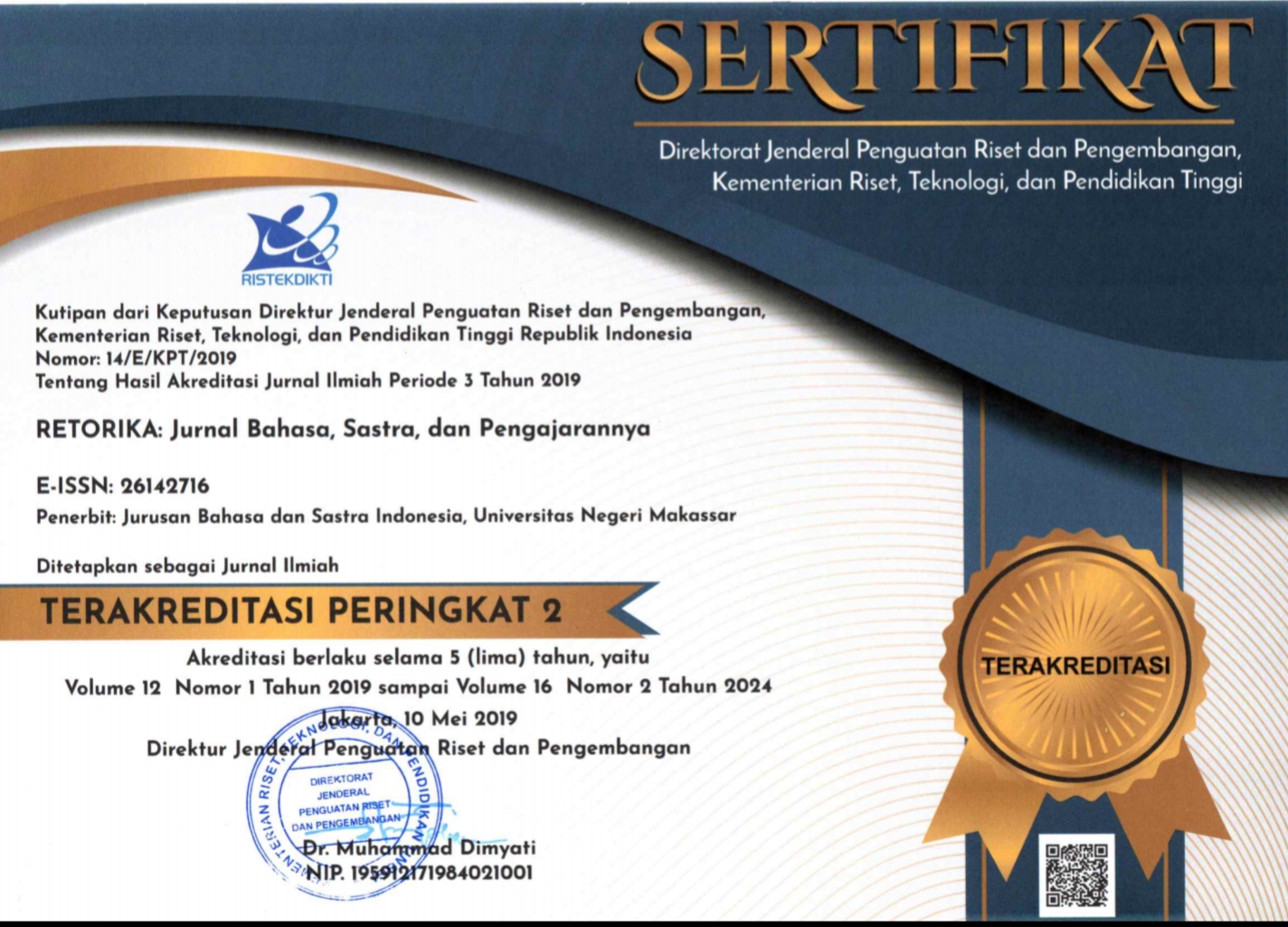MASCULINITY IN JAVANESE PEOPLE: HOW DOES ARJUNA MASCULINITY DESCRIBE IN JAVANESE VERSION OF MAHABHARATA
(1) Universitas PGRI Madiun
(2) Faculty of Teacher Training and Education, Sebelas Maret University, Indonesia
(3) Faculty of Teacher Training and Education, Sebelas Maret University, Indonesia
(*) Corresponding Author
DOI: https://doi.org/10.26858/retorika.v15i2.14909
Abstract
Masculinity in Javanese People: How does Arjuna Masculinity Describe in Javanese version of Mahabharata. Masculinity is a form of maleness construction toward man. Man is not just born with his masculinity naturally, instead it is formed by culture. In a puppetry figure, Arjuna figure is a description of man for Javanese people. Arjuna has a Javanese knight figure. This research, therefore, aims to find out and describe the masculinity of Arjuna’s character in Javanese Mahabharata story by Nano Riantiarno. Data used in the research is lingual units, which are sentences in discourses. The research data source uses a book entitled “Mahabarata Jawa (Javanese Mahabharata)” by Nano Riantiarno. The analysis technique is document analysis with interactive model as its data analysis technique. The research result indicates that there is a figure of Arjuna in the Javanese Mahabharata story that has masculinity characters. There are three masculinity characters of Arjuna, namely: Be a Big Wheel, Be a Sturdy, Give em Hell.
Keywords
Full Text:
PDFReferences
Adinkrah, M. (2012). Social Science & Medicine Better dead than dishonored : Masculinity and male suicidal behavior in contemporary Ghana. Social Science & Medicine, 74(4), 474–481. https://doi.org/10.1016/j.socscimed.2010.10.011
Anderson, E. D. (2009). The Maintenance of Masculinity Among the Stakeholders of Sport. Sport Management Review, 12(1), 3–14. https://doi.org/10.1016/j.smr.2008.09.003
Anthony Synnott. (2003). Tubuh Sosial: Simbolisme, Diri dan Masyarakat. Yogyakarta: Jalasutra.
Basuki, R. (2006). Panakawan’S Discourse of Power in Javanese Shadow Puppet During the New Order Regime: From Traditional Perspective To New Historicism. K@ta: A Biannual Publication on the Study of Language and Literature, 8(1), 68–88. https://doi.org/10.9744/kata.8.1.68-88
Bennett, K. M. (2007). “No Sissy Stuff”: Towards a theory of masculinity and emotional expression in older widowed men. Journal of Aging Studies, 21(4), 347–356. https://doi.org/10.1016/j.jaging.2007.05.002
Berke, D. S., Reidy, D., & Zeichner, A. (2018). Masculinity, emotion regulation, and psychopathology: A critical review and integrated model. Clinical Psychology Review, 66, 106–116. https://doi.org/10.1016/j.cpr.2018.01.004
Bhana, D., & Mayeza, E. (2016). We don’t play with gays, they’re not real boys … they can’t fight: Hegemonic masculinity and (homophobic) violence in the primary years of schooling. International Journal of Educational Development, 51, 36–42. https://doi.org/10.1016/j.ijedudev.2016.08.002
Boothroyd, L. G., Jones, B. C., Burt, D. M., & Perrett, D. I. (2007). Partner characteristics associated with masculinity, health and maturity in male faces. Personality and Individual Differences, 43(5), 1161–1173. https://doi.org/10.1016/j.paid.2007.03.008
Borras-Guevara, M. L., Batres, C., & Perrett, D. I. (2017). Aggressor or protector? Experiences and perceptions of violence predict preferences for masculinity. Evolution and Human Behavior, 38(4), 481–489. https://doi.org/10.1016/j.evolhumbehav.2017.03.004
Cartei, V., Banerjee, R., Garnham, A., Oakhill, J., Roberts, L., Anns, S., … Reby, D. (2020). Physiological and perceptual correlates of masculinity in children’s voices. Hormones and Behavior, 117(October 2019), 104616. https://doi.org/10.1016/j.yhbeh.2019.104616
Dixson, B. J. W., Rantala, M. J., Melo, E. F., & Brooks, R. C. (2017). Beards and the big city: displays of masculinity may be amplified under crowded conditions. Evolution and Human Behavior, 38(2), 259–264. https://doi.org/10.1016/j.evolhumbehav.2016.10.009
Evans, T. (2019). Some Knights are Dark and Full of Terror: The Queer Monstrous Feminine, Masculinity, and Violence in the Martinverse. Journal of Language, Literature and Culture, 2856. https://doi.org/10.1080/20512856.2019.1679446
Frederick, D. A., Shapiro, L. M., Williams, T. R., Seoane, C. M., McIntosh, R. T., & Fischer, E. W. (2017). Precarious manhood and muscularity: Effects of threatening men’s masculinity on reported strength and muscle dissatisfaction. Body Image, 22, 156–165. https://doi.org/10.1016/j.bodyim.2017.07.002
Grieve, R., March, E., & Van Doorn, G. (2019). Masculinity might be more toxic than we think: The influence of gender roles on trait emotional manipulation. Personality and Individual Differences, 138(July 2018), 157–162. https://doi.org/10.1016/j.paid.2018.09.042
Hiramoto, M. (2012). Don’t think, feel: Mediatization of Chinese masculinities through martial arts films. Language and Communication, 32(4), 386–399. https://doi.org/10.1016/j.langcom.2012.08.005
Hunt, C. J., Gonsalkorale, K., & Murray, S. B. (2013). Threatened masculinity and muscularity: An experimental examination of multiple aspects of muscularity in men. Body Image, 10(3), 290–299. https://doi.org/10.1016/j.bodyim.2013.02.007
Ismail, S. F. S. (2014). In Pursuit of Mr. Right: Constructed Masculinities in Malay Teen Magazine. Procedia - Social and Behavioral Sciences, 155(October), 477–483. https://doi.org/10.1016/j.sbspro.2014.10.325
Ismail, T., Wiyantoro, L. S., Meutia, & Muchlish, M. (2012). Strategy, Interactive Control System and National Culture: A Case Study of Batik Industry in Indonesia. Procedia - Social and Behavioral Sciences, 65(ICIBSoS), 33–38. https://doi.org/10.1016/j.sbspro.2012.11.087
Kolay, S. (2016). Cultural Heritage Preservation of Traditional Indian Art through Virtual New-media. Procedia - Social and Behavioral Sciences, 225(November 2015), 309–320. https://doi.org/10.1016/j.sbspro.2016.06.030
Leap, B. (2017). Survival narratives: Constructing an intersectional masculinity through stories of the rural/urban divide. Journal of Rural Studies, 55, 12–21. https://doi.org/10.1016/j.jrurstud.2017.07.010
Lexy J. Moleong. (2011). Metodologi Penelitian Kualitatif. Bandung: Remaja Rosdakarya.
Mbizvo, G. K., Bennett, K., Simpson, C. R., Susan, E., & Chin, R. F. M. (2019). ur na l P of. Epilepsy Research, 106192. https://doi.org/10.1016/j.eplepsyres.2019.106192
Meier-Pesti, K., & Penz, E. (2008). Sex or gender? Expanding the sex-based view by introducing masculinity and femininity as predictors of financial risk taking. Journal of Economic Psychology, 29(2), 180–196. https://doi.org/10.1016/j.joep.2007.05.002
Nano Riantiarno. (2016). Mahabarata Jawa. Jakarta: Grasindo.
Nurgiantoro, B. (2019). THE WAYANG STORY IN MODERN INDONESIAN FICTIONS (Reviews on Mangunwijaya and Sindhunata’s Novels). LITERA, Volume 18, 167–184.
Pembayun, A., Perdana, E. G., & Mega, R. I. (2015). Pandawa Lima Game Pewayangan Legenda Mahabharata Untuk Pengenalan Budaya Indonesia. 1(2), 1152–1165.
Pereira, K. J., Silva, C. S. A. da, Havlíček, J., Kleisner, K., Varella, M. A. C., Pavlovič, O., & Valentova, J. V. (2019). Femininity-masculinity and attractiveness – Associations between self-ratings, third-party ratings and objective measures. Personality and Individual Differences, 147(April), 166–171. https://doi.org/10.1016/j.paid.2019.04.033
R. W. Connell. (2000). The Men and the Boys. Cambridge: Polity Press.
Ramli, W. N. R. W., & Lugiman, F. ‘Aini. (2012). The Contribution of Shadow Puppet’s Show through Engaging Social Communication in Modern Society. Procedia - Social and Behavioral Sciences, 35(December 2011), 353–360. https://doi.org/10.1016/j.sbspro.2012.02.098
Ratanatada, F., Sirichai, P., Kaviya, S., Mangalabruks, B., Pavaganun, C., Fujii, Y., & Yupapin, P. P. (2011). Thai puppet performance with projector and light in theatre. Procedia Engineering, 8, 343–347. https://doi.org/10.1016/j.proeng.2011.03.064
Saptodewo, F. (2015). Mempopulerkan Cerita Pewayangan di Kalangan Generasi Muda Melalui Motion Comic. Jurnal Desain, 2(3), 145–156. Retrieved from http://journal.lppmunindra.ac.id/index.php/Jurnal_Desain/article/viewFile/580/546
Supriyadi, B., Sudarwanto, B., & Werdiningsih, H. (2012). In Search of the Power of Javanese Culture against the Cultural Urbanization in Kotagede, Yogyakarta-Indonesia. Procedia - Social and Behavioral Sciences, 68, 676–686. https://doi.org/10.1016/j.sbspro.2012.12.258
Widijanto, T., & Waluyo, H. J. (2018). Wayang Deconstruction in Recent Indonesian Novels. 280(Basa), 553–561.
Wilkinson, S., & Wilkinson, C. (2019). Young men’s alcohol consumption experiences and performances of masculinity. International Journal of Drug Policy, (xxxx), 0–1. https://doi.org/10.1016/j.drugpo.2019.08.007
Article Metrics
Abstract view : 346 times | PDF view : 77 timesRefbacks
- There are currently no refbacks.
Copyright (c) 2023 Cerianing Putri Pratiwi

This work is licensed under a Creative Commons Attribution-NonCommercial 4.0 International License.
Published by:
Department of Indonesian Language, Faculty of Languages and Literature, Universitas Negeri Makassar in cooperate with Asosiasi Dosen Bahasa dan Sastra Indonesia (ADOBSI) and Ikatan Program Studi Pendidikan Bahasa dan Sastra Indonesia (IKAPROBSI).
Address: Department of Indonesian Language Office, DG Building Second Floor, UNM Parangtambung, Daeng Tata Raya Street, Makassar, South Sulawesi, Indonesia
 Email: retorika@unm.ac.id
Email: retorika@unm.ac.id

RETORIKA: Jurnal Bahasa, Sastra,dan Pengajarannya is licensed under a Creative Commons Attribution-NonCommercial 4.0 International License.
















